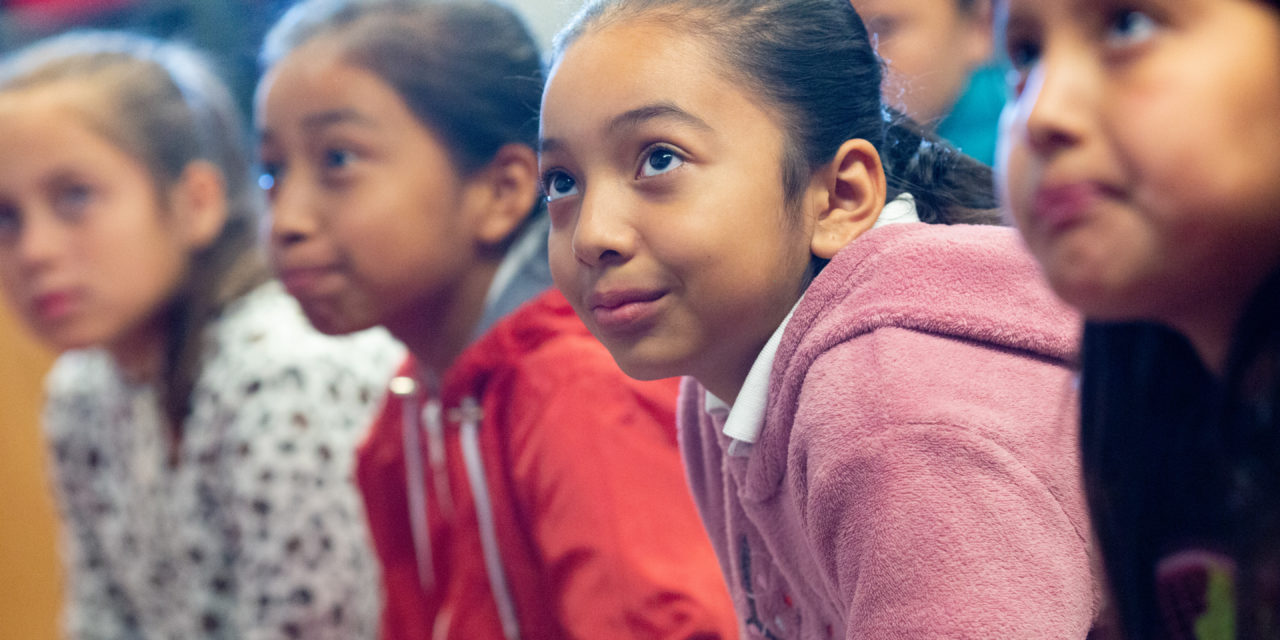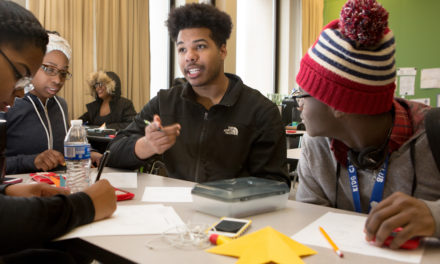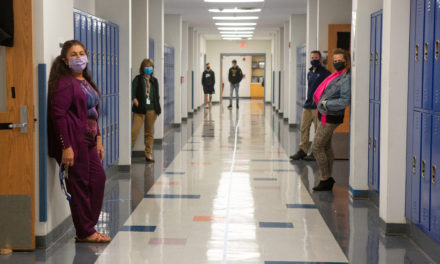“What I’m working on—like making sure students have access to food, clean clothing, and streetlights—may not look like what I’m working on,” Catherine Gilmore told me over a phone call. Gilmore has worked as an educator in Hillsborough County, Florida, for 13 years, and has spent the last six years at Gibsonton Elementary School where she was in the classroom for four years prior to spending the last two years as the community schools coordinator there. During our phone call, she explained to me how her school has addressed its low scores on the state’s school performance report card. And it seems to be working.
In the 2017-2018 school year, Gibsonton received a grade of “D” on the state’s annual report card that assesses elementary schools on the basis of their scores on standardized achievement tests. In 2018-2019, Gibsonton raised its grade to a “C.”
While Gilmore welcomed the progress, she warned against overemphasizing these assessments, calling them “lagging indicators.”
“State standardized testing mostly just identifies student demographics,” she told me, an observation that is validated by research. “Sure, we use data, including test scores. But we use data to drive for the right things rather than letting data get in the way.”
The “right things,” in her view, are the factors—what she spends her time on—that she believes tend to correlate with test scores but are often ignored by school improvement approaches that tend to blame educators when test scores are low.
Often, what can lead to low test scores may have nothing to do with academics. For instance, making sure students are well-fed seems self-evident because students who are hungry aren’t going to do very well at schoolwork. Making sure students have clean clothes seems a little less obvious. But streetlights?
What Gilmore is practicing is an approach to school improvement that is getting more attention—and perhaps a lot more money—as schools reopen from the pandemic; and policy experts, politicians, and pundits hail the restart as a clean slate for drawing up new plans for “redesigning” schools.
Addressing More Than Just a Test Score
The approach Gilmore refers to, called “community schools,” looks at addressing student achievement by responding to the full range of factors in the community that can influence learning, including factors outside of schools.
The approach, as defined by the U.S. Department of Education’s Full-Service Community Schools (FSCS) program, involves “the coordination, integration, accessibility, and effectiveness of services for children and families, particularly for children attending high-poverty schools, including high-poverty rural schools.”
The community schools approach got its first significant national attention in the 2020 presidential campaign when, as Reuben Jacobson from American University’s School of Education wrote in an op-ed for the Hill, “[a]ll of the leading candidates, from Sen. Bernie Sanders (I-Vt.) to former South Bend, Ind., Mayor Pete Buttigieg to Sen. Elizabeth Warren (D-Mass.), … committed to further investing in community schools through their education proposals.”
The profile of the community schools approach rose even higher in April 2021, reported the 74, when the Biden administration proposed a fiscal 2022 budget for the education department that included an increase in spending of $413 million for the FSCS, a nearly 15-fold boost for the program, from $30 million to $443 million.
Days after the budget announcement, U.S. Secretary of Education Miguel Cardona visited an elementary school in Prince George’s County, Maryland—where schools recently reopened—that “is one of 65 ‘community schools’ in the county,” the Washington Post reported, “each considered a hub for family support and social services, along with student learning.” This marked one of the first school visits of his tenure.
‘Our Families Are Struggling to Survive’
Gibsonton Elementary is part of the Hillsborough County Public Schools system, the seventh-largest school district in the U.S., serving nearly 224,000 students. The district is in its third year of implementing the community schools approach, Rob Kriete, president of Hillsborough Classroom Teachers Association, told me.
Kriete taught middle school and high school English for 24 years in Hillsborough County before taking temporary leave to serve as the president of the Hillsborough Classroom Teachers Association, which is affiliated with the state and national teachers’ unions.
Six schools in the district are in their third year of using the community schools approach, two are in their second year, and two more are being added next year.
“We’ve been very intentional about the schools we’ve picked to adopt the approach,” Kriete said, but the district has not taken a “top-down approach,” and has instead chosen schools that seem well-suited to the approach and have leadership and faculty who are agreeable to the demands of it.
Gibsonton Elementary seemed like a good fit. The school is just one of a handful of schools in Gibsonton, an unincorporated, semi-rural community south of Tampa Bay that has its roots in agriculture, light manufacturing, maritime-related businesses, and the carnival industry.
Nearly 20 percent of households in the community are at or below the poverty rate, according to World Population Review, with a median house value of only $188,400, and with 71 percent of adults having attained an education of less than an associate or college degree.
The community seems bereft of many services children and families would need.
Clinics and other health care facilities are sparse and modest and mostly inconvenient to families living near the elementary school. Facilities for dental care and eye care are even rarer. Other than a Walmart Supercenter, there are no grocery stores, so many families have to rely on small convenience stores and bare-bones retailers like Dollar General and Family Dollar that offer very little in the way of fresh and nutritious food.
Gibsonton Elementary also has a student population that often struggles in the public school system. Most of the students (56.4 percent) are Hispanic, according to state data, and nearly all the students are economically disadvantaged (94.1 percent), with 26.3 percent being English language learners, and 23.8 percent having some sort of disability.
“We became a community school because we really needed the outside help,” Gilmore told me. “Our families are struggling to survive,” she said. Many of the school’s families are generational carnival people and live in old and often rundown trailers. Some still leave in May and return in October, which is considered the peak season for the carnival industry.
“There’s so much growth in communities all around us,” she said, referring to the more prosperous Tampa metro area, “but the growth hasn’t improved our community.”
What the Community Really Needs
In March 2018, Gibsonton Elementary leadership, faculty, and support staff agreed the school should adopt the community schools approach. “The entire school had to be behind the idea,” she said, “and we were.” Out of the six candidates who applied for school improvement coordinator, a key position the approach requires, Gilmore was chosen.
Much of what the school needed seemed obvious to Gilmore and her colleagues, but the first year of implementing the community schools model requires the school to conduct a needs assessment, including an audit of program strengths and weaknesses and assets in the surrounding community, and an outreach, via surveys and interviews, to students, parents, business leaders, local nonprofits, and others.
“We interviewed 92 percent of parents, including both parents in two-parent households,” Gilmore recalled. “We really wanted to get a thorough understanding of our stakeholders’ needs and what they felt were the problems.”
After the audit and survey results were accumulated and ranked, the foremost concern was the low rate of student attendance. Parent engagement was also lacking, and families said they wanted a more enriching program for their children—not just the basics.
Poised with that knowledge, Gilmore and her colleagues went about the work of addressing the school’s attendance problems.
But what they had not prepared to address, but were actually better prepared for because they adopted the community schools approach, was a pandemic.
Not a One-Size-Fits-All Approach
“When COVID-19 hit, the first thing we knew we had to do was find [and reach out to] our [students’] families,” Gilmore recalled.
She helped organize a team to make phone calls and canvass neighborhoods. Because of the community’s ties to the carnival business, family mobility rates in Gibsonton were already high. COVID-19 would only make transience worse. Yet, within four weeks, Gilmore and her team found every Gibsonton Elementary student, the first school in Hillsborough County to do so.
“We were 100 percent better able to make the transition [caused by COVID-19] because of the community schools model,” Gilmore said. “Because we were already talking with our families, they weren’t afraid of us. Also, because we had created my position [of school improvement coordinator], we had more capacity. The model ensured we had structures and people in place.”
The dialogue the school had already established with its families also ensured the response to their efforts would be effective.
“The community schools approach was well-suited to the crisis because the approach demands that you stop, ask questions, and listen to those you serve,” Kriete explained. “Another strength of the community schools approach is that it is not a one-size-fits-all approach, and there is a lot of flexibility built into it.”
Based on the community input, the school expanded its on-campus food pantry to include more fresh fruit and vegetables, bread, and fresh meat. For those families who couldn’t come to campus, the school provided prepackaged boxes.
When Florida Governor Ron DeSantis mandated schools reopen for in-person learning in August 2020, Gibsonton Elementary had in place resources and infrastructure to support families still reeling from the pandemic.
Parents who attended the open house found, in their children’s seats, backpacks full of supplies their children would need for the new school year. “I saw parents leaving in tears from the relief that they would start off the year with supplies,” Gilmore recalled. (Parents who couldn’t attend the open house got supplies through the school’s backpack program.)
Every two months, the school sends out fliers asking families what they need, and in one month, that outreach helped 644 families with a wide array of assistance.
“Today I helped a family find a home,” Gilmore told me during our phone call. “In November and December [2020], we helped families deal with evictions and utilities.”
What Raised Reading and Math Scores
Big contributors to Gibsonton’s rise from grade “C” to “D” on Florida’s school performance report card were the school’s dramatic increases in students who achieved learning gains shown in assessment test scores from one year to the next.
Comparing 2017-2018 results to those in 2018-2019, achievement gains in English language arts increased by 12.8 percentage points. The gains were even larger in mathematics, 16.3 points. The increases were more significant for the lowest-performing 25 percent of students, rising by 16.6 percentage points in English language arts and 24.8 points in mathematics.
Gilmore believes much of these gains had to do with the work the school did to increase attendance. But how they went about increasing attendance was guided by their use of the community schools approach.
“When we found out there was a problem with attendance, we asked parents why,” she recalled, and one of the most frequent responses they heard was that not having clean clothes was an impediment to coming to school.
The school responded by installing a campus washer-dryer and eventually opened a clothing closet that provided some free clothing articles.
Another factor contributing to the attendance problem was that in the shorter daylight hours of winter, streets were often too dark for students to safely walk to the bus or to school, and there were too few streetlights.
Given this response, the school organized an effort to have the county install new streetlights around the school. Working with the commissioners, the number of streetlights near the school quickly increased from nine to 51. Attendance immediately improved.
What Gilmore hopes to move to next is to work with a local nonprofit to provide mental health services to help children and families through the social and emotional traumas of the pandemic.
“Having the community schools approach that includes someone like me in place is critical,” she said. “If a school has all these needs, but no one in place specifically focusing on those needs, then that work goes by the wayside. Teachers and principals simply don’t have the time to address these issues.”
(Photo by Allison Shelley/The Verbatim Agency for EDUimages, CC BY-NC 4.0.)






Recent Comments